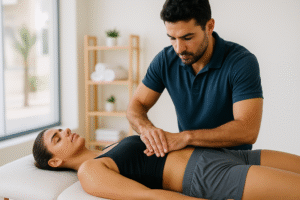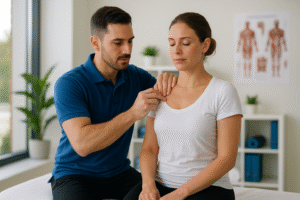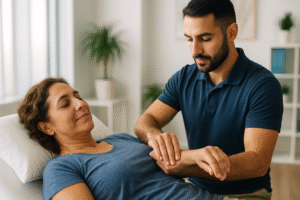
Myofascial Release Guide: Relieve Pain & Restore Mobility
Discover doctor-led myofascial release that targets fascia, eases chronic pain, and boosts flexibility. Personalized manual therapy restores natural movement.
If you're one of the millions of adults battling recurrent low back pain, you've likely been told to "strengthen your core." But this advice often leads to endless, ineffective crunches that can sometimes make the pain worse. The truth is, genuine relief doesn't come from a chiseled six-pack; it comes from understanding and conditioning your body's true support system. This comprehensive guide moves beyond outdated exercises to provide a modern, evidence-based framework for effective core strengthening for back pain. We will explore the science of spinal stability, detail a safe and progressive exercise program, and empower you with the knowledge to build a resilient, pain-free back for the long term.
The first step in any effective back pain rehabilitation program is to correctly identify the "core." Popular fitness culture has incorrectly equated the core with the superficial abdominal muscles, primarily the rectus abdominis (the "six-pack muscle"). While these muscles are involved in movement, they are not the primary stabilizers of your spine. At Physio Cure Dubai, our Doctor-Led philosophy focuses on the root-cause diagnosis, which means targeting the deep, intrinsic muscular system responsible for genuine stability.
Imagine your torso as a strong, supportive canister. The true core forms the walls of this canister:
When these four components work in harmony, they create a system of intra-abdominal pressure that unloads the spine, protects the intervertebral discs, and allows for efficient, pain-free movement. When they are weak or uncoordinated, the spine is left vulnerable, forcing larger, superficial muscles to compensate, leading to strain, fatigue, and chronic pain.
Why is a weak "inner core" so strongly linked to back pain? The answer lies in the concept of stability. Your spine is an incredibly mobile structure, but this mobility comes at the cost of inherent stability. It relies on the surrounding musculature to act as dynamic guy-wires, holding it in a safe, neutral position during daily activities like lifting, twisting, and even walking.
When the inner core is dysfunctional, this system fails. Research shows that in individuals with chronic low back pain, the activation of the transverse abdominis and multifidus is often delayed or absent. Instead of these deep muscles firing pre-emptively to protect the spine, the body relies on larger, global muscles like the erector spinae (the long muscles running up your back) and the rectus abdominis. These muscles are designed for powerful movements, not for fine-tuned stabilization. Their over-activity leads to compressive forces on the spinal discs and facet joints, perpetuating a cycle of irritation and pain.
Key Insight: Effective core training isn't about creating forceful movement; it's about learning to resist unwanted movement. This is the essence of lumbar stability training—teaching the core to brace and protect the spine against external forces.
This is why a proper physiotherapy core program is fundamentally different from a gym workout. It doesn't start with planks and crunches. It starts with re-establishing the mind-muscle connection to these deep stabilizers. It's about teaching the brain to find and activate these dormant muscles again, restoring the body's innate protective mechanism. This foundational work is non-negotiable for achieving lasting relief and building a truly resilient spine.
Beginning a core strengthening program when you're in pain can be intimidating. The key is to start with exercises that isolate the deep core stabilizers without stressing the sensitive structures of the lower back. The goal here is neuromuscular re-education—waking the muscles up—not building brute strength. At Physio Cure, our Doctor-Led treatments ensure every patient begins at the right level, focusing on perfect form. The following exercises form the bedrock of most successful back pain prevention workouts.
Once you have mastered the foundational movements with perfect form and no pain, you can progress to more challenging exercises. These movements build on the stability you've developed and prepare your body for the dynamic demands of sport and daily life. They are essential components of effective back pain prevention workouts. Remember, quality of movement always trumps quantity of repetitions. If your form falters, it's better to stop the set or regress to an easier variation.
When considering these advanced movements, it's helpful to understand the full picture. As detailed in a comprehensive overview of core strengthening for low back pain, the benefits are significant, but they hinge on proper execution and progression. Pushing too hard, too soon, is a common pitfall.
1. The Side Plank: This is a powerhouse for the lateral stabilizers of the core, like the quadratus lumborum and obliques, which are crucial for pelvic stability when walking and running.
Progression: Start with a modified side plank on your knees. Progress to a full side plank on your feet. For an advanced challenge, add a leg lift or a "thread the needle" rotation.
2. The Glute Bridge: While often seen as a glute exercise, this is a phenomenal core stability drill that teaches you to extend your hips without arching your lower back.
Progression: Master the two-legged bridge first. Then, progress to a single-leg bridge, which dramatically increases the stability challenge on the pelvis and core. You can also add a resistance band around your knees to engage your hip abductors.
3. The Pallof Press: This is one of the best "anti-rotation" core exercises back pain sufferers can do. It trains the core to resist the twisting forces that are often a mechanism for back injury.
Progression: Use a resistance band or cable machine. Start in a tall kneeling position to isolate the core. As you get stronger, progress to a half-kneeling or standing stance to make it more dynamic and functional.
Pro-Tip: When performing any core exercise, focus on your exhale. A slow, forceful exhale (like fogging up a mirror) naturally engages the TVA and pelvic floor, enhancing spinal stability and making the movement safer and more effective.
True and lasting back health isn't built in 30-minute exercise sessions alone. It's built by integrating the principles of core stability into every moment of your day. The goal of your physiotherapy core program is to make this stability automatic, so you don't have to think about engaging your core before you pick up a grocery bag or your child. This is where the clinic's core value of "Patient Education & Injury Prevention" becomes paramount.
For some, achieving this requires a more specialized approach. Conditions like chronic pain, postpartum recovery, or postural dysfunctions demand a nuanced understanding that goes beyond generic exercises. For instance, our expert team includes specialists like Dr. Shaimaa Hamdalla, whose focus on Women's Health and Postural Dysfunctions ensures that new mothers and office workers receive care tailored to their unique biomechanics. Similarly, Dr. Mina Gamil's expertise in Complex Musculoskeletal Disorders is invaluable for patients whose back pain hasn't resolved with conventional methods. This commitment to 100% Personalized Care is what transforms a set of exercises into a life-changing rehabilitation plan.
Your journey to a pain-free back is a partnership. It combines your commitment to performing the exercises correctly with the diagnostic expertise of a professional who can identify your specific movement dysfunctions and guide you through a safe, effective progression. By embracing this holistic, evidence-based approach, you're not just treating your pain—you're building a stronger, more resilient foundation for a lifetime of healthy activity.
Ready to move beyond temporary fixes and build a truly resilient back? Our doctor-led team is here to create your personalized recovery plan. Learn more about our advanced back pain treatment programs today!

Discover doctor-led myofascial release that targets fascia, eases chronic pain, and boosts flexibility. Personalized manual therapy restores natural movement.

Learn how doctor-led trigger point therapy at Dubai’s leading clinic conquers chronic muscle knots, boosts mobility, and delivers lasting, root-cause pain relief.

Discover how joint manipulation targets pain at its source, boosts mobility, and speeds recovery. Explore doctor-led physiotherapy for lasting relief.

Discover doctor-led soft tissue mobilization that targets pain, breaks scar tissue, and restores full movement. Book evidence-based physiotherapy in Dubai.

Endometriosis pain doesn’t have to rule your life. Physiotherapy targets root causes, releases pelvic tension, and restores comfort. Book a consult today.

Discover doctor-led physiotherapy for pregnancy lower back pain relief. Gain root diagnosis, customized exercises, and guidance for a pain-free journey.
Physio Cure Dubai, located in Dubai Silicon Oasis, offers a comprehensive range of physical therapy services. Our team of the best physiotherapists in Dubai are all real doctors providing personalized care, using the latest technologies and evidence-based techniques to help you, your child, and your loved ones recover and live a pain-free life.
DHA License No. 5411940
1510, SIT Tower, Dubai Silicon Oasis